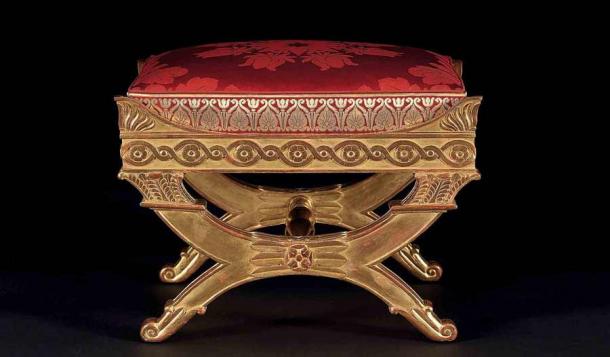Recently, two amazing discoveries were made in the commune of Epagny Metz-Tessy, in the Haute-Savoie department in southeastern France, near Annecy. After an SNC group carried out routine inspections and excavations prior to giving the all-clear on new housing construction on the site, they stumbled upon two Roman funeral pyres from the 1 st century AD. The burial artifacts included a stunning Roman military ruler’s curule chair and furniture associated with the upper classes. The remarkable curule chair was a rare find among a wider range of high-class burial artifacts.
Clearly these funeral pyres were perfect examples of Roman burial rituals 2000 years ago. And from the evidence found one can immediately understand that the Romans buried their dead with their possessions, a practice common to many other cultures, and that this particular site, based on the furniture unearthed there, was dedicated to a pair of aristocrats or otherwise elite Romans.
The French archaeological research group Inrap (National Institute for Preventive Archaeological Research), under the leadership of scientific manager Emmanuel Farber, has taken over management of the site. Their recent scientific report provides detailed insights into the nature of the artifacts found within the Roman funeral pyres of Epagny Metz-Tessy, France.

A small portion of the high-class Roman grave goods found in the second funeral pyre. The curule chair is at the top. (©Emmanuel Ferber, INRAP)
The Funeral Pyres: Artifact Treasure and a Rare Curule Chair
The Inrap report about the Epagny Metz-Tessy finds describes the funeral pyre artifacts in great detail.
The first pyre was richly endowed and contained 17 ceramic vessels, 10 bronze vases, four glass containers, a funeral bed, several boxes, and three copper-alloy strigils (a Greek/Roman scrapping tool for cleaning the body). The pyre also held the remains of a young child (5-8 years old). Interestingly, the glass containers contained food remnants that revealed the luxurious dietary possibilities in that period. These included wine, lentils, beans, pork and a domesticated rooster. Contemporary records of the time indicate that such high-quality foods were definitely markers of higher social status.
The second pyre was built for an adult, as evidenced by the remains and the furniture found in it. The votive offerings in this pyre were more or less the same but there were more of them. In all the second pyre contained 20 ceramic vases, 20 glass containers, 46 bronze utensils and crockery, and even more lavish food deposits. The food evidence in this pyre included wine, lentils, beans, cow, pig, rabbit, fish, partridge and duck! In addition to this, a pair of beautiful gold earrings, golden embroidery on a finely woven fabric, and a silver strigil were also found in the second pyre.

The metal remains of the recently found Roman curule chair as it was discovered. (©Emmanuel Ferber, INRAP)
The Grand History of Roman Curule Chairs
The choicest find from the second pyre was the Roman folding curule chair . Made from iron, this fabulous find is glazed with bronze, and was found folded up. The curule chair seating design indicates that leather or fabric straps were once stretched across the seat. Like other curule chairs, the chair in its unfolded position resembles the letter “X.” It is interesting to note that a lot of modern furniture, usually in the form of small, generally portable tables and chairs, follows this design style.

A folding Spanish wooden curule chair, which shows how the design of this kind of chair progressed steadily from ancient Roman times. (Slay / Public domain )
If you’ve seen the picture of Napoleon Bonaparte at his coronation and reception in 1805, you would have noticed the finely crafted curule seat that was part of the celebration.
Curule chairs originated in ancient Roman times and were used throughout Europe until the dawn of the 20 th century. In ancient Rome, curule chairs were a symbol of high social status, and this symbolic message was echoed in other civilizations and historical periods.
The first curule chairs were built and used in Etruria, central Italy. The word curule is synonymous with the authority of senior magistrates, consuls and praetors in ancient Rome, who were entitled to sit in these S-leg shaped sella curulis chairs. The curulis seat, a privilege reserved for civil magistrates, became a luxury household item from the 1 st century onwards.
During the reign of Augustus (63 BC – 14 AD), the curule chair was one of the symbols of the ruling emperor.
The X-legged sella castrensis chairs, on the other hand, were symbols of elite military officers and their families.

A European sella curulis curule chair made of wood and gilded from Berlin circa 1810 AD. (John Jason / CC BY-SA 4.0 )
The Significance of the Curule Chair Find
In elite burials, curule chairs are generally found carved on the stele or burial stone. This serves the function of reminding the public of the deceased’s civil and social role.
However, it is very rare to find curule chairs buried with the dead. A paltry total of eight curule chairs have been found in France. And the sella curulis curule chair recently discovered in one of the funeral pyres is only the fourth one every found in France.
With the addition of the gold earrings, it would not be too presumptuous to conclude that the second pyre is that of a woman.
Top image: The curule chair being excavated at the Épagny Metz-Tessy Commune site. Source: ©Emmanuel Ferber, INRAP)
By Rudra Bhushan
Related posts:
Views: 0
 RSS Feed
RSS Feed

















 April 7th, 2021
April 7th, 2021  Awake Goy
Awake Goy  Posted in
Posted in  Tags:
Tags: 
















